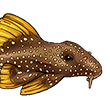| Scientific Name | Leporacanthicus joselimai Isbrücker & Nijssen, 1989 |
| Common Names | L264, Sultan Pleco Sultan-sugemalle (Denmark) |
| Type Locality | Rio Tapajós, perta de Itaituba, Maloquinha, Pará State, Brazil. |
| Pronunciation | lepor ah KAN thi cuss - joe see LIM eye |
| Etymology | Latin, lepus, leporis = rabbit + Greek, akantha = thorn. Named to honour Professor José Lima de Figueiredo of University of Sao Paolo. |
| Size | 98mm or 3.9" SL. Find near, nearer or same sized spp. |
| Identification | All Leporacanthicus spp. have a small backwards facing slightly proud blunt thorn-like plate on top of their heads. Grey with black spots. Juveniles (< 9-10 cm) have white tips on their fins, which fades to yellow as the animals mature. |
| Sexing | Adult males have a much longer and broader head with small odontodes on the sides of head, more odontodes on pectoral fin spine and on the whole body, a bigger dorsal fin and normally a prettier coloration. |
| Distribution | South America: Tapajós River basin, Brazil. Amazon, Lower Amazon, Tapajós (click on these areas to find other species found there) Login to view the map. |
| IUCN Red List Category | Vulnerable , range map and more is available on the IUCN species page. Last assessed 2018. |
| pH | 6.0 - 7.6 |
| Temperature | 25.0-27.0°C or 77-80.6°F (Show species within this range) |
| Other Parameters | Sensitive to nitrites and nitrates above 50 mg/l. Prefers neutral or acid pH, but can tolerate mildly hard water. |
| Feeding | Not a fussy eater. Primarily herbivorous, but appreciates some meat in its diet. Will eat sinking pellets and vegetables such as cucumber, and relishes meaty foods such as krill. According to some reports, in nature it feeds on insect larvae. Fry require more protein in the form of baby brine shrimp, etc. User data. |
| Furniture | Caves and crevices formed by driftwood. |
| Compatibility | Gets on with small lively catfish but avoid too many other larger bottom dwellers (unless space permits) due to the territorial disputes. More active when kept in a group. |
| Suggested Tankmates | Most small to medium community fish. Tetras and South American cichlids are ideal, unless you really go for it when providing a strong water current. |
| Breeding | Documented in the DATZ special issue ''Loricariids 2'' , September 2001. |
| Breeding Reports | There are 8 breeding reports, read them all here. |
| Reference | Die Aquarien- und Terrarienzeitschrift (DATZ) v. 42 (no. 9), pp 546, Figs. 11, 16-17. |
| Registered Keepers | There are 225 registered keepers, view all "my cats" data. |
| Wishlists | Love this species? Click the heart to add it to your wish list. There are 33 wishes to keep this species, see who wants what. |
| Spotters | Spotted this species somewhere? Click the binoculars! There are 86 records of this fish being seen, view them all. |
| Forum BBCode | |
| Search for L. joselimai | |
| Look up L. joselimai on AquaticRepublic.com | |
 | Look up L. joselimai on Fishbase |
 | Look up L. joselimai on Encyclopedia of Life |
 | Look up L. joselimai on Global Biodiversity Information Facility |
| LFS label creator ARN ref:1.4.64.230 | |
| Last Update | 2025 Jan 01 12:01 (species record created: 2001 Apr 25 00:00) |





/siluriformes/loricariidae/leporacanthicus/joselimai/1.jpg)
/siluriformes/loricariidae/leporacanthicus/joselimai/2.jpg)
/siluriformes/loricariidae/leporacanthicus/joselimai/3.jpg)
/siluriformes/loricariidae/leporacanthicus/joselimai/4.jpg)
/siluriformes/loricariidae/leporacanthicus/joselimai/5.jpg)
/siluriformes/loricariidae/leporacanthicus/joselimai/6.jpg)
/siluriformes/loricariidae/leporacanthicus/joselimai/7.jpg)
/siluriformes/loricariidae/leporacanthicus/joselimai/8.jpg)
/siluriformes/loricariidae/leporacanthicus/joselimai/9.jpg)
/siluriformes/loricariidae/leporacanthicus/joselimai/10.jpg)
/siluriformes/loricariidae/leporacanthicus/joselimai/11.jpg)
/siluriformes/loricariidae/leporacanthicus/joselimai/12.jpg)
/siluriformes/loricariidae/leporacanthicus/joselimai/13.jpg)
/siluriformes/loricariidae/leporacanthicus/joselimai/14.jpg)
/siluriformes/loricariidae/leporacanthicus/joselimai/15.jpg)
/siluriformes/loricariidae/leporacanthicus/joselimai/16.jpg)
/siluriformes/loricariidae/leporacanthicus/joselimai/17.jpg)